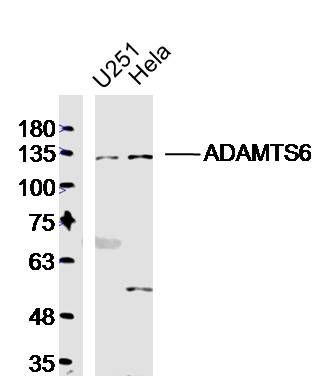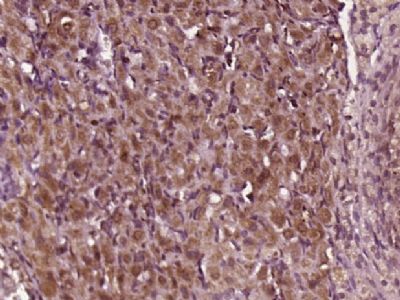产品中心
当前位置:首页>产品中心Anti-ADAMTS6
货号: bs-8009R 基本售价: 1380.0 元 规格: 100ul
- 规格:100ul
- 价格:1380.00元
- 规格:200ul
- 价格:2200.00元
产品信息
- 产品编号
- bs-8009R
- 英文名称
- ADAMTS6
- 中文名称
- 整合素样金属蛋白酶与凝血酶样6蛋白抗体
- 别 名
- A Disintigrin And Metalloproteinase with ThromboSpondin motif 6; ADAMTS 6; Thrombospondin domain 2.ATS6_HUMAN
- 规格价格
- 100ul/1380元购买 200ul/2200元购买 大包装/询价
- 说 明 书
- 100ul 200ul
- 研究领域
- 细胞生物 免疫学 信号转导
- 抗体来源
- Rabbit
- 克隆类型
- Polyclonal
- 交叉反应
- Human, Mouse, Rat, Chicken, Dog, Pig, Cow, Horse, Rabbit, Sheep,
- 产品应用
- WB=1:500-2000 ELISA=1:500-1000 IHC-P=1:400-800 IHC-F=1:400-800 ICC=1:100-500 IF=1:100-500 (石蜡切片需做抗原修复)
not yet tested in other applications.
optimal dilutions/concentrations should be determined by the end user.
- 分 子 量
- 97kDa
- 细胞定位
- 分泌型蛋白
- 性 状
- Lyophilized or Liquid
- 浓 度
- 1mg/ml
- 免 疫 原
- KLH conjugated synthetic peptide derived from human ADAMTS6:231-330/1117
- 亚 型
- IgG
- 纯化方法
- affinity purified by Protein A
- 储 存 液
- Preservative: 15mM Sodium Azide, Constituents: 1% BSA, 0.01M PBS, pH 7.4
- 保存条件
- Store at -20 °C for one year. Avoid repeated freeze/thaw cycles. The lyophilized antibody is stable at room temperature for at least one month and for greater than a year when kept at -20°C. When reconstituted in sterile pH 7.4 0.01M PBS or diluent of antibody the antibody is stable for at least two weeks at 2-4 °C.
- PubMed
- PubMed
- 产品介绍
- background:
This gene encodes a member of the ADAMTS (a disintegrin and metalloproteinase with thrombospondin motifs) protein family. Members of the family share several distinct protein modules, including a propeptide region, a metalloproteinase domain, a disintegrin-like domain, and a thrombospondin type 1 (TS) motif. Individual members of this family differ in the number of C-terminal TS motifs, and some have unique C-terminal domains. [provided by RefSeq, Jul 2008]
Function:
ADAMTS6 was first described along with ADAMTS5 and ADAMTS7 in database searches for proteases containing the metalloprotease domain signature. A member of the metalloproteinase family containing disintegrin-like domains (ADAMs) the function of ADAMTS6 is still poorly understood, and as of this writing no substrates have been shown to be cleaved by ADAMTS6. ADAMTS6 contains the canonical HExxHxxxxxH zinc metalloproteinase motif, and is likely to be an active protease. In addition to the metalloprotease domain, ADAMTS6 has a propeptide domain, a Prohormone Convertase (PC, furin) cleavage site, a cysteine-rich domain, a spacer domain and five thrombospondin 1 like domains. The domain structure of ADAMTS6 is thus most like ADAMTS16 and ADAMTS19. ADAMTS6 does not have a transmembrane domain, unlike many of the ADAMs proteases, and is a secreted protein. Other ADAMTSs family members (ADAMTS4, ADAMTS5) have been more thoroughly studied, and are known to play key roles in aggrecan turnover. Analysis of breast cancer cell lines and RPE cells in the eye show elevated expression of ADAMTS6, and the original paper cited low levels of expression in the placenta. Three human sequences are currently reported, 1117, 860 and 468 amino acids in length respectively. The 860 amino acid sequence has a shorter spacer after the catalytic domain, and ends in the second thrombospondin domain. The 468 amino acid sequence ends at the start of the disintegrin domain. It remains to be seen where these different splice variants are expressed. The 1117 amino acid protein has a predicted mass of 125.27 kDa, the 860 form 97.11 kDa and the 468 form 53.12 kDa, but glycosylation and the abundance of cysteine residues gives ADAMTS6 a greater apparent molecular weight on reduced SDS PAGE gels. The furin consensus motif in ADAMTS6 means that the protein is likely to be cleaved when it is secreted.
Subcellular Location:
Secreted protein; extracellular space; extracellular matrix.
Tissue Specificity:
Expressed at low levels in placenta and barely detectable in a number of other tissues.
Post-translational modifications:
The precursor is cleaved by a furin endopeptidase.
Glycosylated. Can be O-fucosylated by POFUT2 on a serine or a threonine residue found within the consensus sequence C1-X(2)-(S/T)-C2-G of the TSP type-1 repeat domains where C1 and C2 are the first and second cysteine residue of the repeat, respectively. Fucosylated repeats can then be further glycosylated by the addition of a beta-1,3-glucose residue by the glucosyltransferase, B3GALTL. Fucosylation mediates the efficient secretion of ADAMTS family members. Also can be C-glycosylated with one or two mannose molecules on tryptophan residues within the consensus sequence W-X-X-W of the TPRs, and N-glycosylated. These other glycosylations can also facilitate secretion (By similarity).
DISEASE:
Isoform 1 and isoform 2 expressions are up-regulated by TNF in retinal pigment epithelial cells.
Similarity:
Contains 1 disintegrin domain. Contains 1 peptidase M12B domain.Contains 1 PLAC domain.Contains 5 TSP type-1 domains.
SWISS:
Q9UKP5
Gene ID:
11174
Database links:Entrez Gene: 11174Human
Entrez Gene: 108154Mouse
Entrez Gene: 361886Rat
Omim: 605008Human
SwissProt: Q9UKP5Human
Unigene: 482291Human
Unigene: 208125Mouse
Important Note:
This product as supplied is intended for research use only, not for use in human, therapeutic or diagnostic applications.
- 产品图片
 Sample:
Sample:
U251 (Human)CellLysate at 40 ug
Hela (Human) CellLysate at 40 ug
Primary: Anti-ADAMTS6(bs-8009R)at 1/300 dilution
Secondary: IRDye800CW Goat Anti-RabbitIgG at 1/20000 dilution
Predicted band size: 97kD
Observed band size: 125kD Paraformaldehyde-fixed, paraffin embedded (rat ovary tissue); Antigen retrieval by boiling in sodium citrate buffer (pH6.0) for 15min; Block endogenous peroxidase by 3% hydrogen peroxide for 20 minutes; Blocking buffer (normal goat serum) at 37°C for 30min; Antibody incubation with (ADAMTS6) Polyclonal Antibody, Unconjugated (bs-8009R) at 1:400 overnight at 4°C, followed by operating according to SP Kit(Rabbit) (sp-0023) instructionsand DAB staining.
Paraformaldehyde-fixed, paraffin embedded (rat ovary tissue); Antigen retrieval by boiling in sodium citrate buffer (pH6.0) for 15min; Block endogenous peroxidase by 3% hydrogen peroxide for 20 minutes; Blocking buffer (normal goat serum) at 37°C for 30min; Antibody incubation with (ADAMTS6) Polyclonal Antibody, Unconjugated (bs-8009R) at 1:400 overnight at 4°C, followed by operating according to SP Kit(Rabbit) (sp-0023) instructionsand DAB staining.

